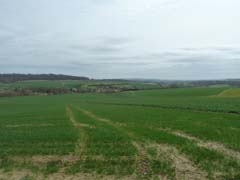Prochain point : lat="" lon=""

Hilly panorama of French Vexin
A village in the crux of the valley
The etymology of Sailly comes from the Latin salictum meaning "place planted with willows." The village originated in 832, when the Abbey of Saint Denis owned land here. Grouped around the church and the steeple, which can be seen from here, the village lies in the hollows of the valley, on either side of the river Montcient spreading slightly up the slopes. It has recently been extended linearly up to the boundary of the agricultural plateau on the northern slope.
Grain fields: shelter of the Hen Harrier
In the farming landscape of French Vexin where grain is the main crop, an emblematic host can be seen: the Hen Harrier. An elegant bird of prey that is easy to spot flying low over the crops, this species has the particularity of nesting on the ground, preferably in fields of wheat or barley. The female incubates the eggs on the ground for about ten days, and the young remain in the nest for about a month. The male can be identified by its blue-grey plumage, black wing tips and white rump. The female is larger, with brown plumage on top and yellow-beige striped with brown underneath. It feeds primarily on voles and small birds thus helping to protect the crops.
Large isolated farms
Saint-Laurent and Malmaison are two isolated plateau farms in the municipality of Brueil-en-Vexin. They are located near the top of the hill on the edge of the forest and agricultural land. They are likened to imposing fortresses, with their closed quadrangle, tight formation of attached buildings and blind outer walls to ward off danger and intrusion. Their closed formation protects the life and activities that focus on the central courtyard.




